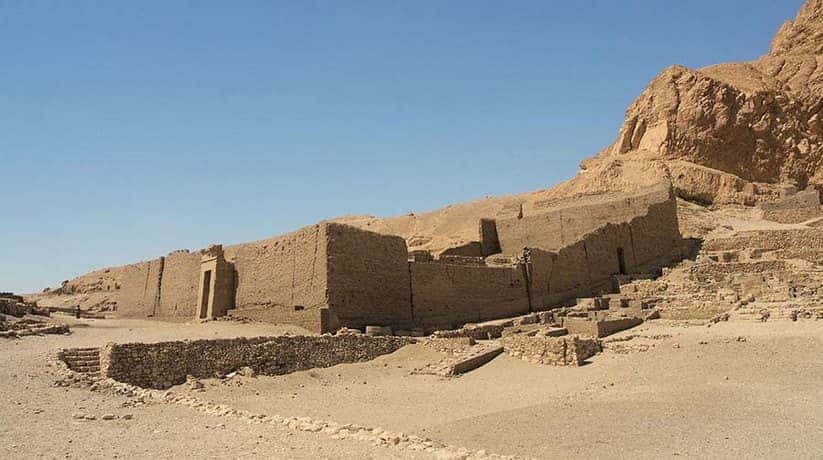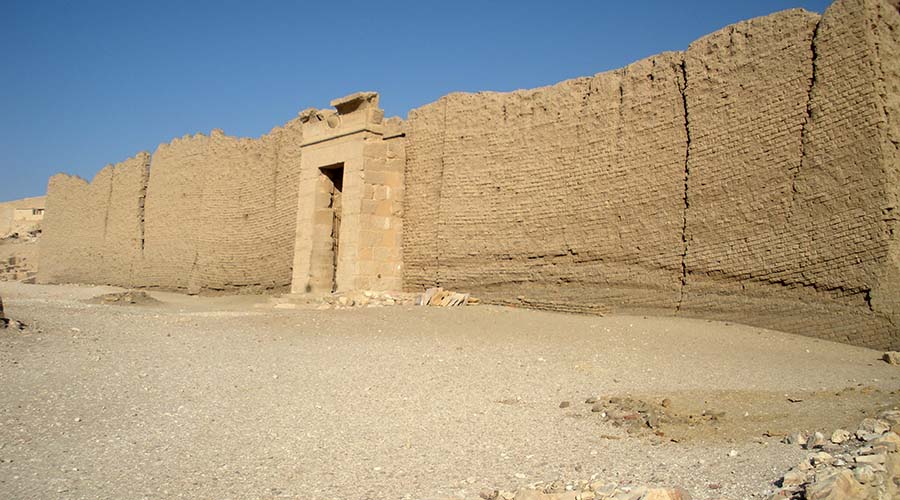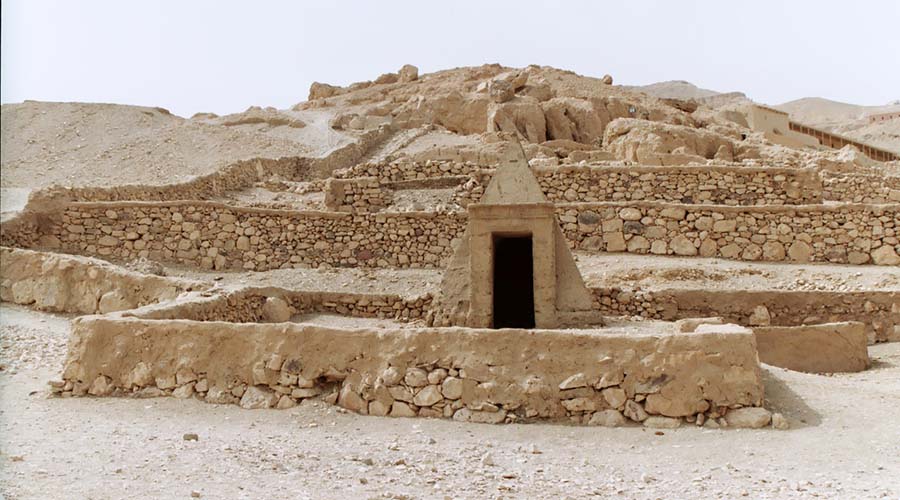Deir El Medina Luxor Egypt tours, booking, prices, reviews
Deir El Medina Luxor is the Arabic name of a village in the Theban necropolis. In fact, Deir El Medina Luxor once occupied by the pharaohs’ tomb builders. It also occupied by the artisans of New Kingdom Thebes. It’s name means “Monastery of the Town”. In fact, it derives from the Coptic monks who occupied the Ptolemaic temple there. It was during the early Christian period. In ancient times Deir El Medina known as “Set Ma’at” (the Place of Truth) or “Pa-demi” (the town). We do not know exactly when the Deir founded. Bricks discovered in the original enclosure wall stamped with Thutmose I name. It is although Queen Ahmose-Nefertari and her son Amenhotep I revered by the inhabitants. They are of early Dynasty XVIII.
In fact, a cult temple of Amenhotep I situated at the northern end of the village. Little known about the earliest settlement here which destroyed by fire. But later during the reign of Horemheb the houses restored and the village expanded. The remaining structures in Deir El Medina today date back to Dynasties XVIII, XIX and XX. There were excavations, restorations and study in recent years. They carried out by the French Institute of Oriental Archaeology (IFAO). Deir El Medina yielded a huge amount of information. It is about the daily lives of the inhabitants, their families and relationships. Moreover, it is also about their working and living conditions. A great deal of textural material in the form of papyri and Ostraka have found. Ostraka is large flakes of limestone or pottery sherds which used for sketches and jottings.
Further details about Deir El Medina Luxor:
In fact, a massive collection of figured Ostraca recovered. It is especially from “the Great Pit”, a wide deep hole to the north of the Temple of Hathor. It thought that the pit dug by the villagers in search of water. Such settlement sites are indeed rare. There were discoveries of similar communities at Giza. They date back to the Old Kingdom and Kahun, from the Middle Kingdom. They together with Deir El Medina build a picture of the lives of the common people of ancient Egypt. In fact, the community at the Deir consisted of the workers and craftsmen. They employed in the construction of the New Kingdom royal Tombs of Valley of Kings. It occupied an area of around two hectares. with seventy dwellings enclosed within the original walls. It is about fifty more outside during the Ramesside period.
The residential area approached from the northern end. It is where a well located and had a broad central street. The street runs north to south with houses on either side. Moreover, the houses at Deir El Medina all built to a similar plan from mud bricks. They were with four small rooms. An internal staircase leads to a terrace or upper room and sometimes a cellar. Furthermore, the flat roofs constructed from planks of wood from palm tree. The internal walls plastered with gypsum and painted white and floors were of stone. Moreover, there was a large brick structure in the corner of the entrance hall. It entered by a short flight of steps. Thought to be either a domestic shrine or a bed platform. It used in childbirth (or perhaps both combined). The platform would often decorated with depictions of the god Bes.
More details about Deir El Medina Luxor:
In fact, God Bes who associated with childbirth as well as being a household god. The main room lit by high clerestory windows. It had a low raised platform and stelae. They dedicated to ancestor cults and to Meretseger, goddess of the Theban necropolis. Moreover, a storage area also used as sleeping quarters. A kitchen area with an oven and an open roof was at the rear of the house. Furthermore, the door lintels and jambs of the houses painted red. They often inscribed with the name of the inhabitant’s family. They seem to have inherited by family members. The family members who usually carried on the position or trade of the householder. They elevated their position, the grander their house. The community isolated and had little contact with the outside world. In fact, it was maybe for security reasons.
They governed by the Vizier of Upper Egypt. His local representative was the “Scribe in the Place of Truth” or “Scribe of the Tomb”. The tomb builders assigned to two gangs. In fact, they worked on the left side or the right side of the royal Tombs. Each gang or “Iswt” was responsible for the work on their own side under a foreman. Each gang consisted of stonemasons, droughts men, artists, carpenters and sculptors. Moreover, they had their own deputies, guards and door keepers. The door keepers were responsible for the security of the workplace and discipline of the men. The workmen guarded by the “Medjay” or necropolis guards. The tomb builders walked to the Kings Valley over the mountain on paths. The paths still used today. Perhaps they spent part of their shift sleeping in “stopover villages”.
Further details about Deir El Medina Luxor:
The workmen paid in grain and other provisions such as fish, vegetables, water oil and salt. On special occasions such as festivals, they given a holiday and bonuses. The bonuses consisted of extra rations of food such as meat or poultry and other “luxuries”. When work on a royal tomb slowed down the workers laid off for a time. Records show that the craftsmen would often have employed in more menial tasks. They also supplemented their income by taking private commissions. The private commissions enabled the workers to construct Tombs and burial goods. It was for themselves and their families. This worked on the principle of bartering their skills. Many Ostraca have found which record the buying and selling of goods. It was between the inhabitants of the village.
There are also records of disputes at Deir El Medina. They were in the village inevitable in a small isolated community. One such dispute recorded between two individuals, Amen-nakht and Paneb. It was over the office of foreman after the death of Amen-nakht’s brother. There were also disputes over settlement of property theft and blasphemy. During the reign of Ramses III a labor strike by the workmen considered necessary. It was after a long period of reduced rations. The strike seems to have produced the desired result. More provisions soon made available. It was to be the first of several such strikes over pay and conditions. Deir El Medina Luxor had its own judiciary system. It comprised of leading members of the community. They settled all minor matters of crime or dispute. Only the more serious cases needed to go before the vizier’s court.
More details about Deir El Medina Luxor:
Much of our information comes from the workmen who buried in pyramid Tombs. The tombs which surround Deir El Medina Luxor. One of the early inhabitants of the village was an architect and foreman. It was during the reigns of Thutmose III to Amenhotep III. He named Kha. His intact burial was one of the major archaeological discoveries in the village. It found in 1906 and now reconstructed in the Turin Museum. His tomb contained high quality burial goods. It including tomb furnishings, jewelry, papyri and pottery and bronze vessels. In the houses themselves many objects have found. It including baskets or pots containing foodstuffs and cosmetic products. They which tell us about the lives of these families.
Many textural documents and stories have found at Deir El Medina in the form of papyri and Ostraca. There is a huge pit at the northern end of the Deir. It is beyond the Ptolemaic temple, in which thousands of Ostraca found. Moreover, it contained letters, records of births, deaths and marriages. It also included many aspects of religion and law about the inhabitants. There seems to have been quite a high level of literacy in Deir El Medina. It is especially among the women. Women would have had the responsibility of running the household. It was when their husbands were away working. The demise of the workmen’s village came about at the end of Dynasty XX. It was during a period of turmoil and civil war. The inhabitants moved into a new village.
Further details about Deir El Medina in Luxor:
It was within the walls of nearby Medinet Habu protect them from Libyan attack. The village of Deir El Medina abandoned to the desert. Only the temples and shrines continued to visited. By the end of Dynasty XX the remaining workmen were under the “protection” of the high priests of Amun. It was at Medinet Habu. It was before the instability of the Third Intermediate Period brought about the end of an era. During the Ptolemaic Period a Temple of Hathor constructed at the northern end of Deir El Mednia. It was on the site of earlier remains. In fact, it converted into a Coptic church and monastery. Deir El Medina Luxor was also the site of an important Graeco Roman cemetery. The workmen’s village lay buried by sand. It was until it found by Ernesto Schiaparelli following the discovery of the tomb of Kha.
How to get to Deir El Medina Luxor:
Deir El Medina situated behind the hill. The hill separates the modern villages of Qurnet Murai and Sheikh Abd El Qurna. It is around 10 minutes walk from the Antiquities Inspectorate. The village usually approached today from the southern end. Only entrance to the main street allowed. Ticket includes entrance to Deir El Medina and the tombs of Sennedjem. It also includes Inherkau and the Temple of Hathor. It costs 30 Egyptian pound from the main ticket office. An extra ticket needed for the tomb of Peshedu.
















